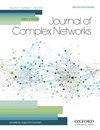带离群值的随机块模型中群落数量的估计
IF 1.5
4区 数学
Q2 MATHEMATICS, INTERDISCIPLINARY APPLICATIONS
引用次数: 0
摘要
随机块模型(SBM)是一种流行的社区检测模型。目前已经提出了许多社区检测方法,但大多数方法都假设社区的数量是预先给定的。然而,在实践中,社区的数量往往是未知的。人们提出了许多估算社区数量的方法,但大多数方法都是计算密集型的。此外,当存在异常值时,没有办法一致地估计社区的数量。本文提出了一种基于正则化和归一化邻接矩阵特征值的快速估计带有异常值的SBM下的群落数的方法。结果表明,当存在异常值时,我们的方法可以一致地估计社区的数量。此外,我们将该方法推广到度校正SBM。我们在模拟中证明了我们的方法与其他现有方法相当。我们还在四个现实世界的网络中说明了我们的方法。本文章由计算机程序翻译,如有差异,请以英文原文为准。
Estimating the number of communities in the stochastic block model with outliers
The stochastic block model (SBM) is a popular model for community detecting problems. Many community detecting approaches have been proposed, and most of them assume that the number of communities is given previously. However, in practice, the number of communities is often unknown. Plenty of approaches were proposed to estimate the number of communities, but most of them were computationally intensive. Moreover, when outliers exist, there are no approaches to consistently estimate the number of communities. In this article, we propose a fast method based on the eigenvalues of the regularized and normalized adjacency matrix to estimate the number of communities under the SBM with outliers. We show that our method can consistently estimate the number of communities when outliers exist. Moreover, we extend our method to the degree-corrected SBM. We show that our approach is comparable to the other existing approaches in simulations. We also illustrate our approach on four real-world networks.
求助全文
通过发布文献求助,成功后即可免费获取论文全文。
去求助
来源期刊

Journal of complex networks
MATHEMATICS, INTERDISCIPLINARY APPLICATIONS-
CiteScore
4.20
自引率
9.50%
发文量
40
期刊介绍:
Journal of Complex Networks publishes original articles and reviews with a significant contribution to the analysis and understanding of complex networks and its applications in diverse fields. Complex networks are loosely defined as networks with nontrivial topology and dynamics, which appear as the skeletons of complex systems in the real-world. The journal covers everything from the basic mathematical, physical and computational principles needed for studying complex networks to their applications leading to predictive models in molecular, biological, ecological, informational, engineering, social, technological and other systems. It includes, but is not limited to, the following topics: - Mathematical and numerical analysis of networks - Network theory and computer sciences - Structural analysis of networks - Dynamics on networks - Physical models on networks - Networks and epidemiology - Social, socio-economic and political networks - Ecological networks - Technological and infrastructural networks - Brain and tissue networks - Biological and molecular networks - Spatial networks - Techno-social networks i.e. online social networks, social networking sites, social media - Other applications of networks - Evolving networks - Multilayer networks - Game theory on networks - Biomedicine related networks - Animal social networks - Climate networks - Cognitive, language and informational network
 求助内容:
求助内容: 应助结果提醒方式:
应助结果提醒方式:


